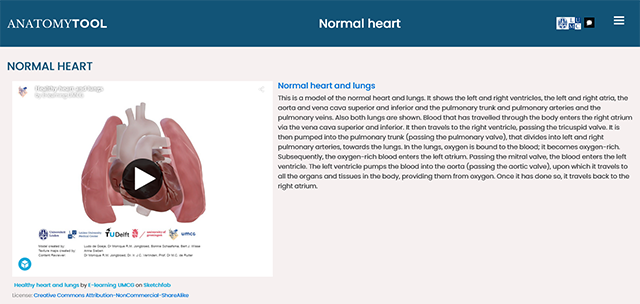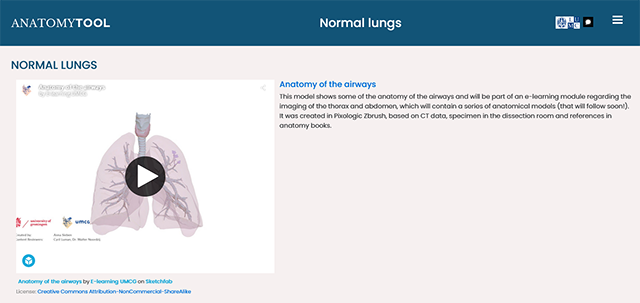NORMAL ANATOMY (for comparison)
Reference page with 3D models of the heart anatomy.
Reference page with 3D models of the lung anatomy.
CONGENITAL HEART DISEASES
ASD is a defect in the septum between the heart’s two upper chambers (atria).
This model shows an atrioventricular septal defect, hence a combined atrial and ventricular septum defect. A window was made in the right atrium to enable a view into the hart.
This model shows a 4 chamber plane cut through a heart with an atrioventricular septal defect to show the anatomy as seen on the ultrasound image.
This model shows a heart with a bicuspid aortic valve (BAV). A BAV is an aortic valve that only has two leaflets, instead of three. The aortic valve regulates blood flow from the heart into the aorta. The aorta is the major blood vessel that brings oxygen-rich blood to the body.
A BAV may not be completely effective at stopping blood from leaking back into the heart. This leakage is called aortic regurgitation. The aortic valve may also become stiff and not open up. This is called aortic stenosis and causes the heart to pump harder than usual to get blood through the valve. The aorta may become enlarged.
A BAV often exists in babies with coarctation of the aorta. BAV is also seen in diseases in which there is a blockage to blood flow on the left side of the heart.
Coarctation of the aorta, also called aortic narrowing, is a congenital condition whereby the aorta is narrow. When a patient has a coarctation, the left ventricle has to work harder. Because the aorta is narrower, the left ventricle must generate a much higher pressure than normal in order to force enough blood through the aorta to deliver blood to the lower part of the body. If the narrowing is severe, the left ventricle might not be powerful enough to push blood through the coarctation, which results in a lack of blood to the lower half of the body.
Coarctation of the aorta, also called aortic narrowing, is a congenital condition whereby the aorta is narrow. When a patient has a coarctation, the left ventricle has to work harder. Because the aorta is narrower, the left ventricle must generate a much higher pressure than normal in order to force enough blood through the aorta to deliver blood to the lower part of the body. If the narrowing is severe, the left ventricle might not be powerful enough to push blood through the coarctation, which results in a lack of blood to the lower half of the body.
This model depicts the morphology of a common arterial trunk (CAT), a rare congenital disease. In this condition, the embryological structure known as the truncus arteriosus fails to properly divide into the pulmonary trunk and aorta.
Double aortic arch is an abnormal formation of the aorta, the large artery that carries blood from the heart to the rest of the body. It is congenital; present from birth.
Normally, the aorta develops from one of several curved pieces of tissue (arches). As babies develop in the womb, the arches split into several parts. The body breaks down some of the arches, while others form into arteries. A normally developed aorta is a single arch that leaves the heart and moves leftward.
In double aortic arch, some of the arches that should have disappeared are still present at birth in addition to the normal arch. Babies with a double aortic arch have an aorta that is made up of two vessels instead of one. The two parts to the aorta have smaller arteries branching off of them
Partial anomalous pulmonary venous connection (PAPVC) is a rare congenital cardiac defect. In PAPVC, the blood flow from a few of the pulmonary veins return to the right atrium instead of the left atrium. Usually, a single pulmonary vein is anomalous. This model shows a PAPV, where the anomalous right superior pulmonary pulmonary vein drains via the Superior Vena Cava into the right atrium instead of the left atrium.
This model shows the tetralogy of Fallot. Two windows were made to enable a view inside the heart; one in the right ventricle and one in the left ventricle. Tetralogy of Fallot is is a congenital heart defect (a problem considering the structure of the heart that is present by birth). It involves four heart defects:
- A large ventricular septal defect (VSD)
- Pulmonary stenosis
- Right ventricular hypertrophy
- An overriding aorta.
This model shows the tetralogy of Fallot (parasternal long axis view). Two windows were made to enable a view inside the heart; one in the right ventricle and one in the left ventricle. Tetralogy of Fallot is is a congenital heart defect (a problem considering the structure of the heart that is present by birth). It involves four heart defects:
- A large ventricular septal defect (VSD)
- Pulmonary stenosis
- Right ventricular hypertrophy
- An overriding aorta.
In a transposition of the main arteries, the two main arteries are switched. The aorta connects to the right ventricle, instead of the left ventricle. The pulmonary trunk connects to the left ventricle, instead of to the right ventricle. Because of this, the pulmonary and the systemic circulation, which are normally connected, are separated. The oxygen-rich blood in the pulmonary circulation flows through the lungs, then via the left atrium and ventricle back into the pulmonary artery and back into the lungs. Deoxygenated blood flows through the body into the caval veins to the right atrium and ventricle into the aorta, back into the aorta. Hence, the oxygen that is breathed in, never reaches the systemic circulation and carbon dioxide produced in the body never reaches the lungs to be expired; a lethal situation.
This model shows a cut through a heart with transposition of the great arteries as it would show in a long axis echo plane. In case of a transposition of the main arteries, the places of the two main arteries are switched. The aorta connects to the right ventricle, instead of the left ventricle. The pulmonary trunk connects to the left ventricle, instead of the right ventricle. Because of this, the pulmonary and the systemic circulation, which are normally connected, are separated. The oxygen-rich blood in the pulmonary circulation flows through the lungs, then via the left atrium and ventricle back into the pulmonary artery and back into the lungs. Deoxygenated blood flows through the body into the caval veins to the right atrium and ventricle into the aorta, back into the aorta.
This model shows a cut through a heart with transposition of the great arteries as it would show in a short axis echo plane. In case of a transposition of the main arteries, the places of the two main arteries are switched. The aorta connects to the right ventricle, instead of the left ventricle. The pulmonary trunc connects to the left ventricle, instead of the right ventricle. Because of this, the pulmonary and the systemic circulation, which are normally connected, are separated. The Oxygen-rich blood in the pulmonary circulation flows through the lungs, then via the left atrium and ventricle back into the pulmonary artery and back into the lungs. Deoxygenated blood flows through the body into the caval veins to the right atrium and ventricle into the aorta, back into the aorta.
Transposition of the great arteries is a congenital (present at birth) heart defect. Because of abnormal development of the fetal heart druing the first 8 weeks of pregnancy, the large vessels that carry blood from hte heart to the lungs, and to the body are improperly connected. Essentially, the connections in the heart are ‘swapped’; in transposition of the great arteries, the aorta is connected to the right ventricle and the pulmonary artery is connected to the left ventricle. Because of this, two separate circuits are formed; one that circulates oxygen-poor blood and one that circulates oxygen-righ blood. The presence of other heart defects allows for some mixing of the circulations; An opening in the atrial or ventricular septum will allow oxygen-rich and oxygen-poor blood to mix. Patent ductus arteriosus (the connection between the aorta and the pulmonary artery) such as in this model also allows for some mixing of blood. Because of this, at least some oxygen is provided to the body.
The arterial switch surgery is the most common surgery these days to correct a transposition of the great arteries (TGA).
What happens during the surgery?
- The arteries are cut just above the heart valves
- The coronary arteries are cut from the aorta and attached to the artery that goes to the lungs. The holes in the aorta are closed.
- The aorta is moved to the base of the pulmonary trunk. This will form the new aorta.
- The pulmonary trunk is moved and attached to the base of the aorta. These two together will form the new pulmonary artery.
This will result in a bloodflow that is similar to the flow from a normal heart.
This model shows atresia of the tricuspid valve. The tricuspid valve, usually situated between the right atrium and the right ventricle, was not constructed. Because of this, there is a decreased blood flow, which has resulted in the suboptimal development of the right ventricle. Hence the small (hypoplastic) right ventricle. Since the right ventricle cannot pump the blood into the lungs, the blood has to get there in a different way. This is accomplished by surgery: the Fontan procedure. The surgeon attaches all vessels that usually go to the right atrium directly to the lungs. Those vessels contain oxygen-poor blood from the upper part of the body (Superior Vena Cava) and the lower part of the body (Inferior Vena Cava) and are attached directly to the lungs via a tunnel, the Fontan tunnel. Oxygen is bound to the blood cells in the lungs. This oxygen-rich blood then enters the left atrium, the right ventricle and is pumped by the left ventricle into the body.
This model shows atresia of the tricuspid valve. The tricuspid valve, usually situated between the right atrium and the right ventricle, was not constructed. Because of this, there is a decreased blood flow, which has resulted in the suboptimal development of the right ventricle. Hence the small (hypoplastic) right ventricle. Since the right ventricle cannot pump the blood into the lungs, the blood has to get there in a different way. This is accomplished by surgery: the Fontan procedure. The surgeon attaches all vessels that usually go to the right atrium directly to the lungs. Those vessels contain oxygen-poor blood from the upper part of the body (Superior Vena Cava) and the lower part of the body (Inferior Vena Cava) and are attached directly to the lungs via a tunnel, the Fontan tunnel. Oxygen is bound to the blood cells in the lungs. This oxygen-rich blood then enters the left atrium, the right ventricle and is pumped by the left ventricle into the body.
A ventricular septal defect (VSD) is a defect in the ventricular septum, the wall dividing the left and right ventricles of the heart. The extent of the opening may vary from pin size to complete absence of the ventricular septum, creating one common ventricle. Perimembranous VSD’s are located in the membranous septum, a relatively small portion of the septum located near the heart valves. Muscular VSD’s are located in hte muscular portion of the ventricular septum. Many of these muscular VSD’s close spontaneously and do not require surgery. The model depicts both a muscular and a perimembranous VSD.
 View license
View license If you use this item you should credit it as follows:
- For usage in print - copy and paste the line below:
- For digital usage (e.g. in PowerPoint, Impress, Word, Writer) - copy and paste the line below (optionally add the license icon):
"Congenital heart diseases" by Anna Sieben, UMCG and Monique R.M. Jongbloed, license: CC BY-NC-SA






Comments